The HTC 10 Review
by Joshua Ho on September 19, 2016 8:00 AM ESTSystem Performance Cont'd
Now that we've discussed how the HTC 10 performs in general purpose task we can turn our attention to tests that attempt to better test how a device performs in 3D gaming and other tasks that more strongly emphasize GPU and 3D API performance.

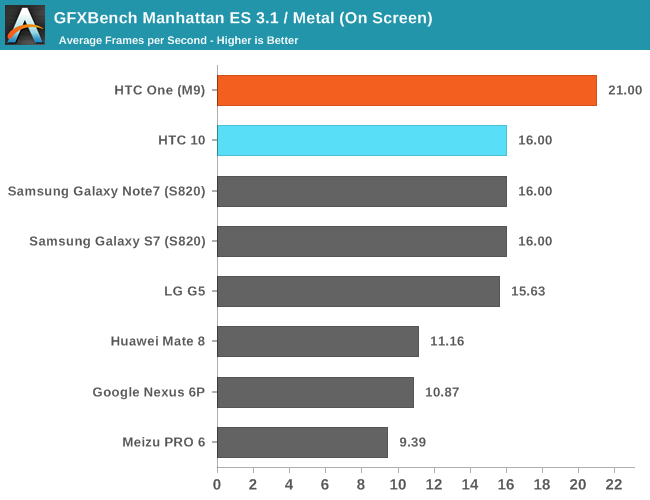


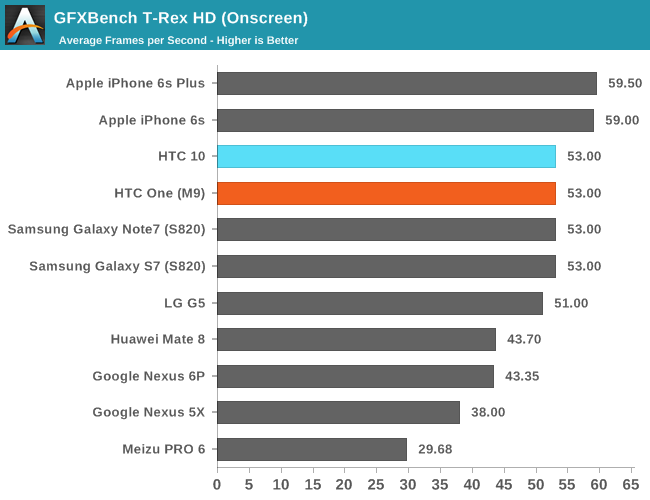
In the on-screen tests we can see the impact that the extra resolution has on GPU performance. Despite Adreno 530 providing a significant performance uplift the HTC 10 can actually give less GPU performance at native resolution depending upon the workload. Car Chase is fairly tesselation-intensive and uses ES 3.1, while ES 2 and ES 3 tests like Manhattan and T-Rex see parity between the two.
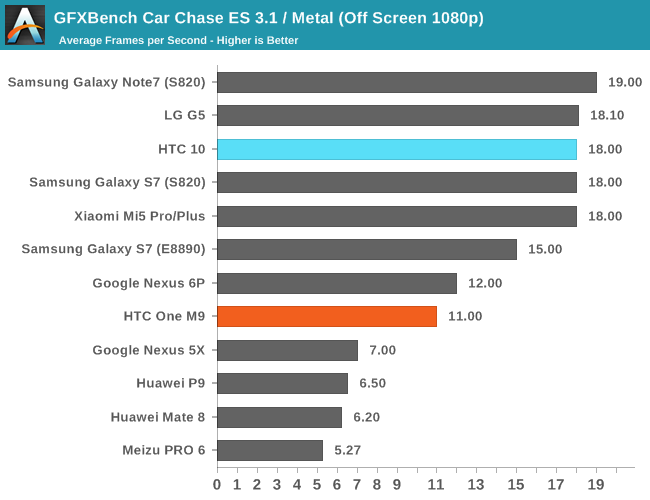
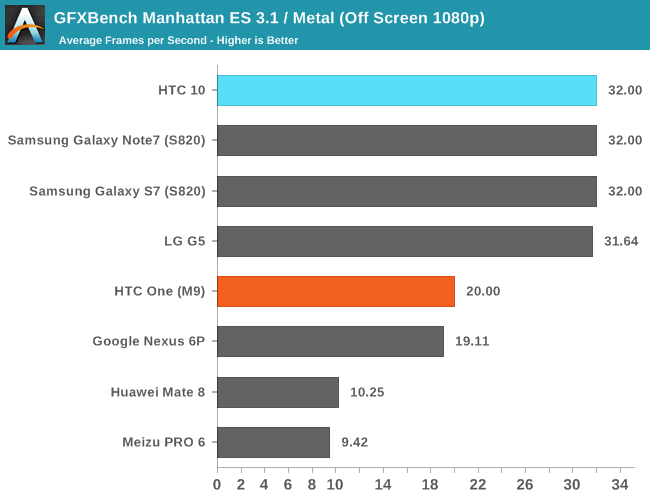
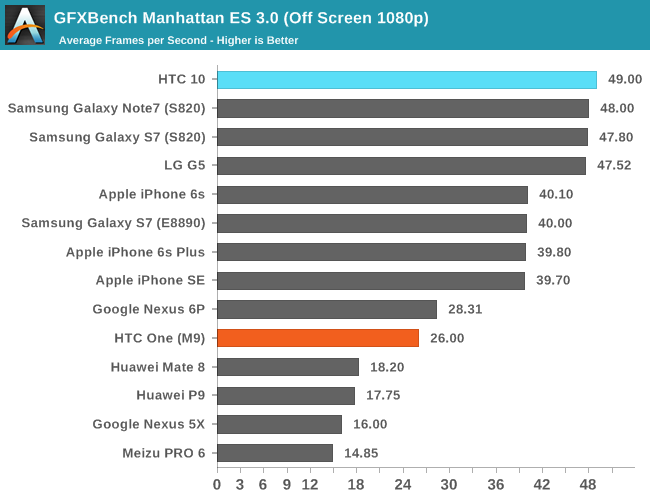
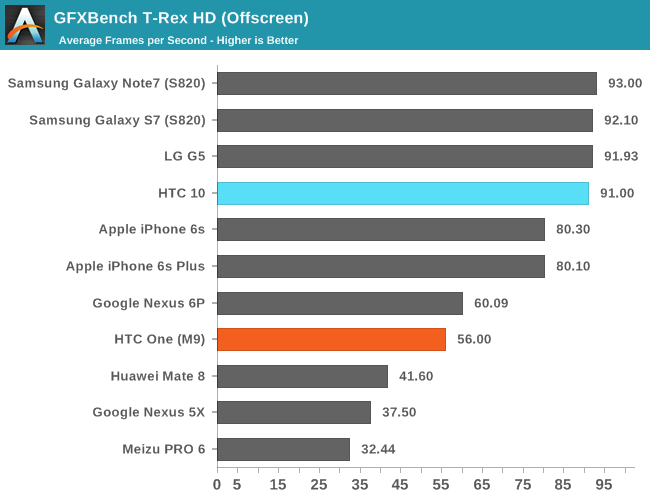
In 1080p off-screen rendering we see performance similar to applications that would render at non-native resolutions. Here the HTC 10 significantly outperforms the One M9 across the board and is in line with other Snapdragon 820 devices which is probably not a surprise.
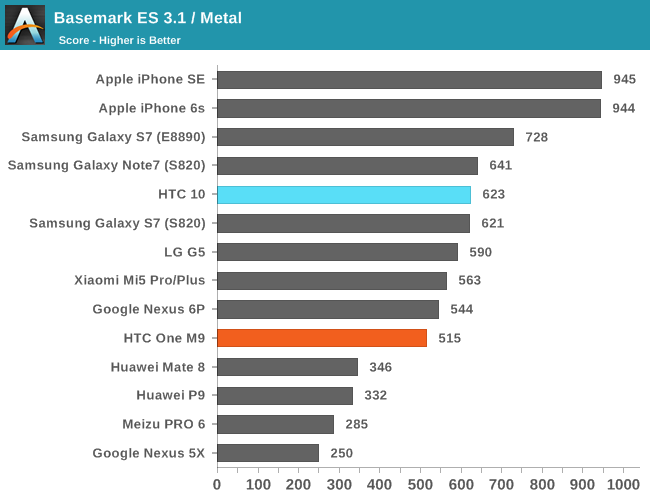
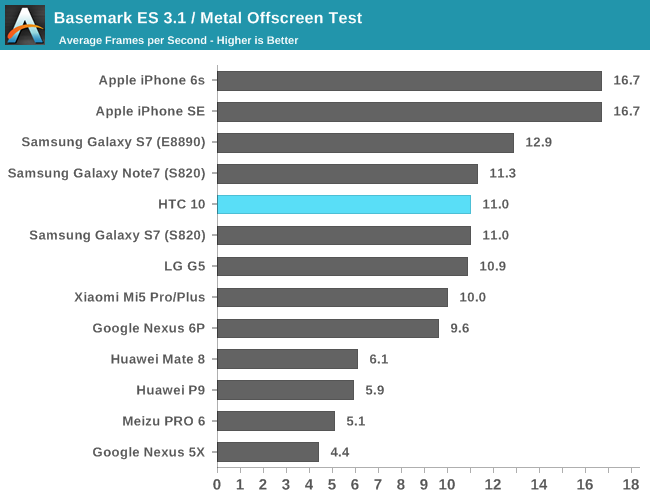
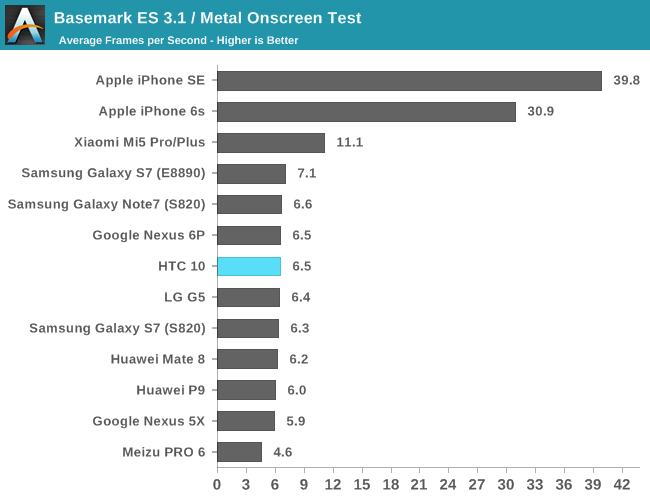
Performance here shows an uplift over the One M9, but this is primarily because the scores are based upon the off-screen results where resolution is equalized.
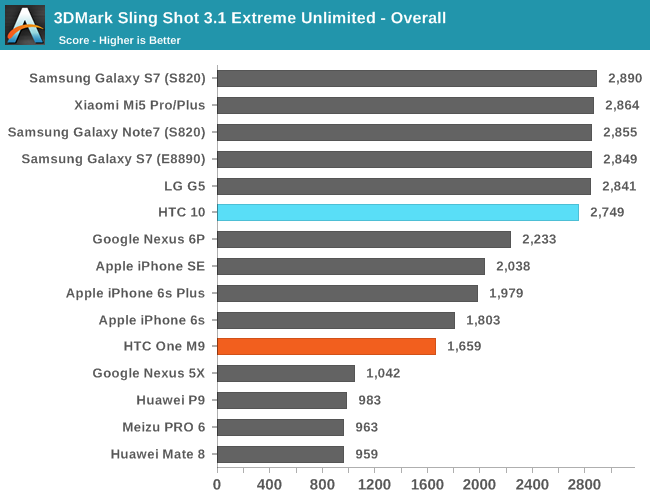
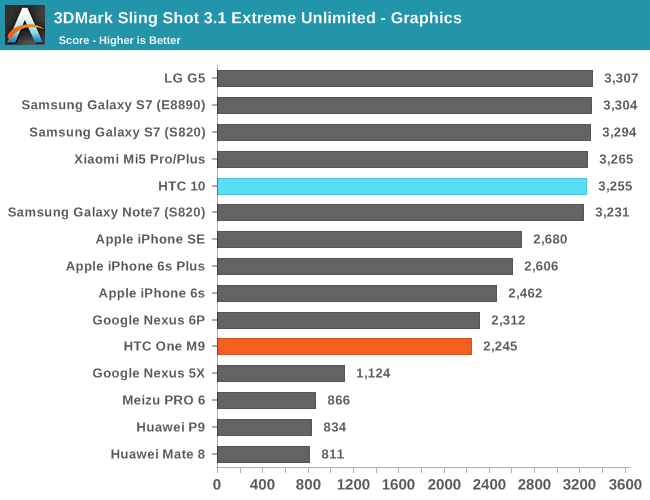
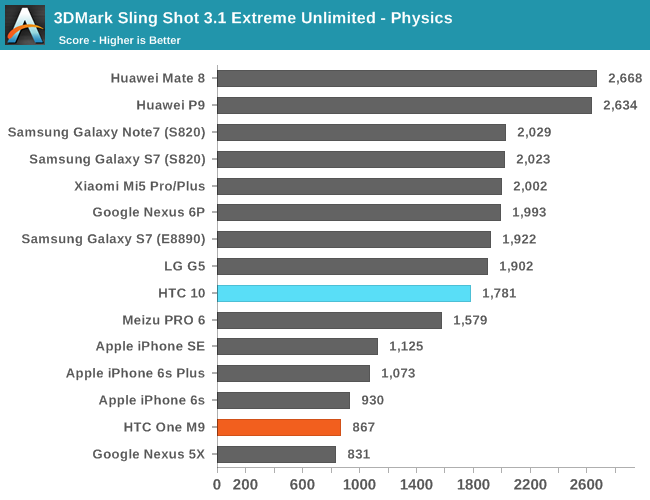
As 3DMark relies on off-screen rendering again we can see the benefit of Adreno 530 over Adreno 430 but this can only be achieved if you use the game optimization settings in the Boost+ application. Overall this isn't particularly notable outside of simple verification that nothing is seriously wrong with the software and hardware on the HTC 10.
NAND Performance
Storage performance, while decidedly difficult to test well in the mobile space and generally not all that well covered remains a fairly critical component of overall system performance. It’s definitely possible to hide memory performance issues with caching, but if you’ve ever taken a course on these things you can see that there is an upper bound to performance when it comes to caching. As a result, being able to improve performance at each step of the memory mountain is critical to having low latency and high throughput for data in the system. In order to test storage performance on mobile devices, we continue to rely on AndroBench 4 for Android devices. In order to properly test storage performance in a somewhat realistic manner we elect to test with only one I/O thread and a 100 MB test set with 4KB and 256KB block sizes for random and sequential rather than the strange settings of 8 threads and a 32MB sequential test which seems to be geared towards generating the largest numbers humanly possible rather than any meaningful throughput figure.
In the case of the HTC 10 it’s probably not a surprise at this point but it uses iNAND 7232 from SanDisk, seemingly as a single source supplier. This uses the SLC/TLC hybrid configuration seen in devices like the LG V10, iPhone 6, 6s, and 7 as well. The SLC storage is on the order of a few hundred megabytes, so sequential writes that exceed this size will see a drop-off in performance.
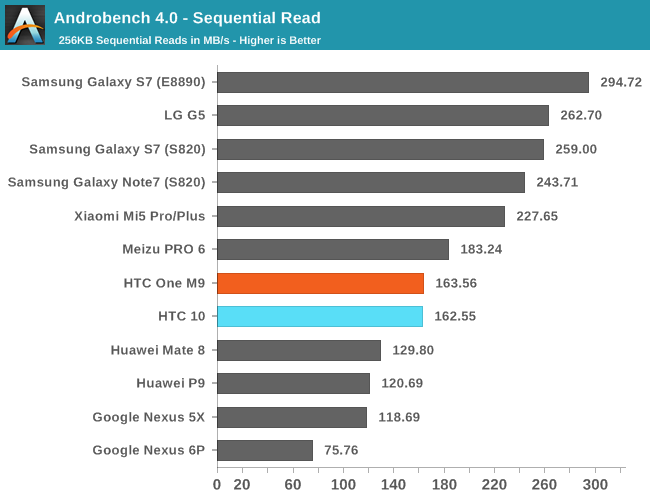
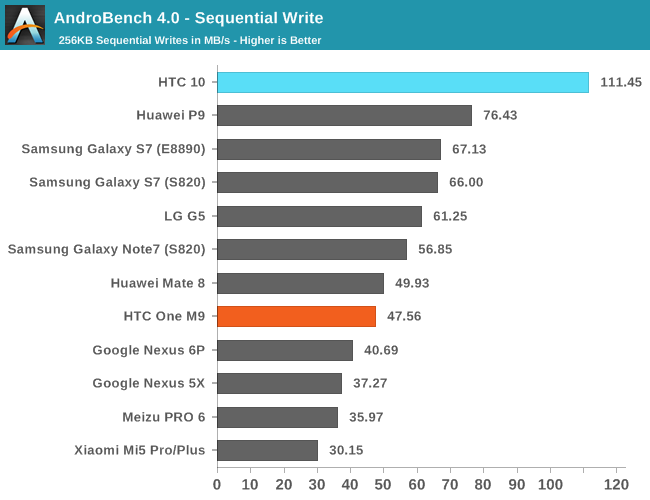
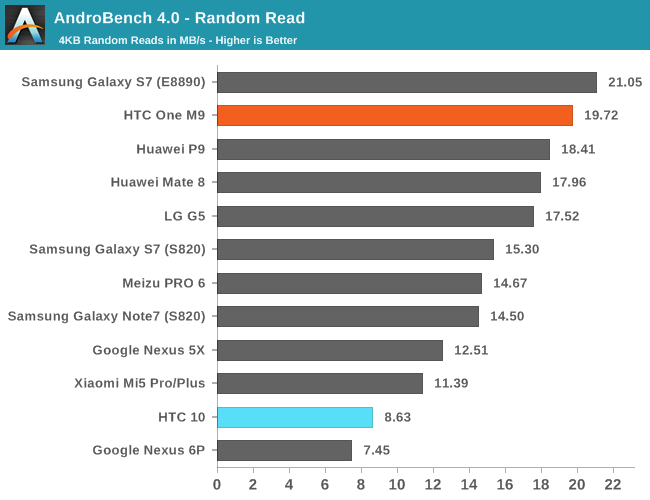
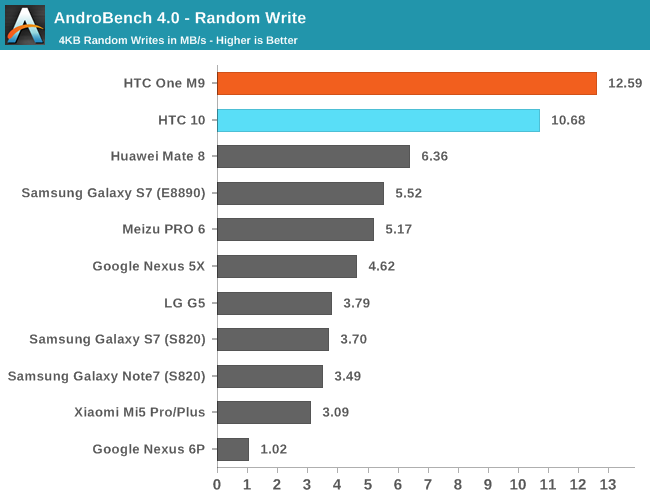
These results are probably not a surprise if you’ve been following our recent coverage but it’s still worth noting how the use of eMMC 5.1 is not guaranteed to be a huge impediment, although I would say this is probably the last generation where it’s acceptable to ship eMMC in a flagship device as the eMMC spec doesn’t seem to be progressing much further and UFS/NVMe solutions really seem to be the way forward as far as the industry is concerned. The HTC 10 is not really that far off from the UFS solutions we’ve seen in phones like the Galaxy S7 and from the Discomark results you can see that the eMMC 5.1 solution used here isn’t really causing a huge difference in performance, but I suspect anything that can actually take advantage of UFS’ more sophisticated controller will really start to highlight the weakness of eMMC and SDIO. At this point the industry already has UFS as a fairly widespread standard so HTC could take this route for a future flagship or NVMe storage depending upon their logistics. It's really important to emphasize here how UFS and NVMe are not necessarily better one way or another, as these things only matter when the storage or storage controller isn't the bottleneck.










183 Comments
View All Comments
Samus - Monday, September 19, 2016 - link
The only worthwhile android device is a $100 android device like the Moto G Play or something. Why waste money on something that is going to lose all its value in a year to get virtually the same experience.I don't get the concept behind premium android devices. Just makes no sense. The most expensive one I've ever considered is perhaps the $300 OnePlus.
Murloc - Monday, September 19, 2016 - link
I guess taking decent pictures or playing 3D games.I don't do that, so I don't buy high end phones.
Murloc - Monday, September 19, 2016 - link
this isn't any different for iOS or WP devices btwphilehidiot - Tuesday, September 20, 2016 - link
I can absolutely see your point. But conversely my girlfriend bought a cheap Android phone and regretted it massively. Granted it was a crap one but she ended up using my 3 year old flagship device which still works brilliantly. The difference is that now she will use her phone for a lot more, including navigation (which destroyed the battery on the old device and couldn't keep up), youtube (useful for reference when doing something on the car or cooking and you don't have a laptop handy) as well as the much better camera. When previously she wouldn't have bothered using the smartphone camera she now does because a) it's not shite and b) the high quality screen means it's actually worth looking at and sharing photos on the phone. The other thing to remember is that the cameras on many a high end smartphone are approaching what you'd get in many compact cameras (albeit without optical zoom) according to Which? magazine here in the UK. Whilst this is debateable by photography nuts it does mean for the average Joe we get a decent enough camera in our pockets all the time. Not only does this mean you always have a decent camera but it means you don't have to buy one - the savings of which you can add to your device budget. You also have the added advantage of your photos being backed up to the cloud and so if your phone does get nicked then you still have the data. This is not something most stand alone cameras can do as they don't have a mobile data connection.I can see your point but when you have a high end phone and use it for a while it's unlikely you'll want to go back. Myself I go through two whole battery charges a day on my M9 (multiple factors but screen on time is the biggest) and that's simply because I use it for reference during work, emails, reading and editing presentations (try watching a powerpoint presentation with attached videos on a low end device), youtube and web browsing at lunch time and a massive mix of things in between including reading in the pub which isn't exactly pleasant after a while on a low end screen. The other advantage to a high end phone is it's more likely to be supported with security and OS updates throughout the product's lifespan. Partly because it has the power to run the newer features (like split screen multitasking - something I'm looking forward to) and partly because that's what the extra profit margin paid towards. You'll also find that, as software is developed based on the average specs out in the wild, as the average phone spec rises you'll be left behind - this means that applications are updated (mandatorily), you'll often find them slowing down over time as they are aiming for higher and higher specifications over the couple of years you own the device.
Whilst there are some damned good low-mid range Android phones out there, I feel that they are ultimately let down by screen, camera, R&D and long term support. I use my phone to such an extent that it's worth every penny to get something that works properly.
Sorry for the long post but I thought you made such a good point about lower end devices that you deserved someone who does invest in a high end model justifying their reasons why.
darkich - Tuesday, September 27, 2016 - link
^ great post, with which I agree completely, aside from the part about understanding the point to which you replied to.I really doubt Samus has used a true high end Android device enough to warrant an credible opinion.
And he's obviously missing the whole world-changing paradigm of computing that's happening before his eyes.
I suggest him to go read the first and last paragraphs of the Note 7 review on the Verge..that guy simply nailed it.
And that's exactly why myself, after using a Note 3 for three years as my main computer, camera, media and gaming device (still serves me amazingly well but the physical wear and tear started to show, the camera and GPU have become outdated, as well as the battery endurance), am now left waiting for the Note 7 re-release.
There's just no alternative for me.
londedoganet - Monday, September 19, 2016 - link
Oh, is that why every second comment on any article is "where's the HTC 10 review, Anandtech has sold its soul and become Apple shills, even Anand has gone to work for Apple"?jfallen - Monday, September 19, 2016 - link
All this in-depth review of the display but not once did you care to look at it though a set of polarized glasses...If you did you'll note that they polarized the display so that the screen appears black when holding the phone in the normal up-right position while wearing polarized sunnies... UNFORGIVABLE!!! design decision and that's why I don't one.
Still rocking the HTC ONE M7 with it's unpolarised screen, MHC and dual front speakers. The original and still the best ;)
ToTTenTranz - Monday, September 19, 2016 - link
I suffer from this issue with my HTC Butterfly 3 (exclusive japanese model that is pretty much what the M9 should've been), which seems to have this very same 5.2" 1440p screen.I have to say it really bothers me having to hold the phone in landscape if I'm wearing my polarized Oakleys.
Demi9OD - Monday, September 19, 2016 - link
I use a matte screen protector and don't have any problems.ChronoReverse - Monday, September 19, 2016 - link
After I put on my TGSP (Orzly), the polarization issue was resolved for mine (Tianma panel)